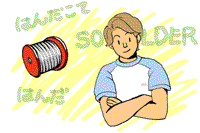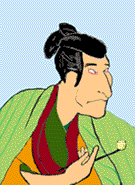

Top of Products > Solder-Aid > HIKARU'S DIARY ON LEARNING TO SOLDER > EPISODE 7: "People in ancient times are great!"




Mr. Tanaka, did soldering exist in ancient times?
Why are you suddenly asking about that? (Laughing) I think that soldering has existed since ancient times. But, I don't know very much about the "history of soldering". Why don't you go to a library to learn the history of soldering by taking this opportunity?
OK. I'll do that.
Next time, you can give me a lecture about it!
Count on me! (Laughing)
Hikaru goes to a library
Well? First, I'm going to search books by the terms "Solder" and "Electronics". Wow, I got it! Let's see ····· Yay!!
Hey! You need to be quiet in the library!
Oh, I'm sorry.
What surprised you so much?
It says that the history of soldering goes back to 3500 B.C.?
Oh! You are interested in "soldering"? You should come to my house to talk about it. We can't talk much in the library.
Excuse me, you are ??
I'm Suzuki. I'm an old guy who is more into soldering than most people.
At Mr. Suzuki's house
Please sit down here. Be careful not to step on the books on the floor.
I'm sorry.
That's OK. What information about soldering did you want to learn in the library?
Well, I would like to know when soldering was used first.
You mean the history of soldering. You were surprised to read that it is said that the history of soldering goes back to about 3500 B.C. Soldered objects were found in the remains of ancient Rome from about 300 B.C.
Soldering has been used for a very long time. But, what was soldered so long ago without electricity?
That's a fundamental misunderstanding. Soldering is not used only for mounting electronic components to a P.W.B. or wiring them. It is also used to join tin or zinc plates. Soldering was used for water pipe joints in the remains of ancient Rome.
Really? Soldering can be used to join such things?
Of course. Indeed, we imagine "electronics" when we think of "soldering". But the soldering in the remains of ancient Rome is related to the field of electronics.
What do you mean?
Don't be surprised! The solder found in the remains of ancient Rome contains 62% tin and 38% lead. These ingredients are almost the same as those of "eutectic solder" that is widely applied in the electronics field today.
Oh, really? ····· And, what is "eutectic solder"?
In principle, solder is composed of tin and lead. Did you know that?
Um?, Yes.
Tin and lead are easily available metals and what's more, they are inexpensive. When both metals are mixed, characteristics of the resultant mixture vary depending on the amount and percentage of the ingredients. The mixture of tin and lead at a ratio of 62% and 38% is called "eutectic solder". Eutectic solder provides the lowest melting temperature and it takes the shortest time to solidify.
The melting temperature is low?. Does this characteristic provide any advantage for soldering?

Sure! Think about this. A "low melting temperature" simplifies soldering work. For soldering work, we must heat up the target metal to the solder's melting temperature or higher temperature, as well as heat up the solder. For this purpose, the soldering tool must be heated up to a higher temperature. If the solder's melting temperature is high, it is difficult to heat up the target metal and the soldering tool. Furthermore, if the target metal is over heated, the metal may be damaged.
I see. Also, which types of soldering irons were used in that time without electricity?
They used metallic irons heated with coal and so on.
Oh, really? People in ancient times were really intelligent. When was soldering used first in Japan?
It is not exactly known but it is said that soldering was used before the eighth century. I hear that soldering was used for Shoso-in and the Great Buddha at Nara. In that time, various handicrafts related to building of the Great Buddha had been created and soldering was used for these handicrafts. In addition, a description of soldering was found in a document created in the Edo era. Do you know about book called "Wakan-sansaizue"?
What is it? Is it an illustrated book for children or something like that?
No! This book, named "Wakan-sansaizue", is an encyclopedia from the Edo era. It is a great book that "Ryoan Terashima", a doctor in Osaka, spent thirty years or longer to edit. All the text was written in classical Chinese, but this book contains many illustrations so we can enjoy it just by browsing through them. Look at this! Ha-ha-ha (Laughing)
……。
This book says that "lead of one kin is mixed and kneaded with Chinese tin of ten ryo, and the mixture is used?."; "one kin" corresponds to about 600g and "ten ryo" corresponds to about 375g. So, this is the description of soldering that uses lead and tin at a ratio of 6 to 4.
Why was such an old technology subjected to little change until now? Other technologies have rapidly changed, haven't they?
That is because ·····. Oops, it's time for me to go out now! Sorry, I'll answer your question another time. You have to go now.
Huh?
